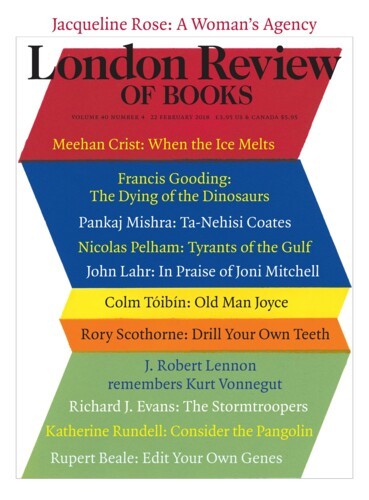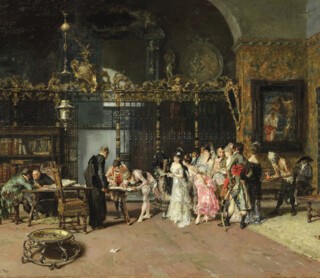Few painters have seen their reputations rise and fall as dramatically as Mariano Fortuny y Marsal. In his lifetime he was considered a master throughout Europe. Gautier ranked his etchings with those of Goya and Rembrandt; for Huysmans, his harmonisation of dissonant colours was an ‘artistic miracle’. Fortuny’s association with a not quite reputable bourgeoisie and lower nobility, and above all with the American industrialists who were among his most enthusiastic patrons, primed him for ignominy, and then obscurity. Less than ten years after his death in 1874, at the age of 36, one Spanish critic was already reviling him as ‘the author of our painting’s decadence’. Fortuny’s work is now little remembered outside his native Spain, and is missing from most major surveys of European art. His entry in the Historical Dictionary of the Catalans consists of only three lines: he ‘produced paintings on Oriental themes’.
Fortuny has languished in the shadow of his far more famous son, Mariano Fortuny y Madrazo, who designed sets for Wagner and costumes for Orson Welles, and whose classic Delphos gown, Proust wrote, had the ability to detach the wearer ‘from the current of everyday life like a scene in a novel’. The Moorish arches and Arabs in djellabas of Fortuny senior were outdated by the turn of the century. He had fallen victim to a variant of Gresham’s Law: his most famous works were imitated and forged, printed on fans, re-enacted in tableaux vivants, and his name became synonymous with the kitsch that profited from it. In Italy, he was confused and then dismissed with his lesser imitators. Yet, as the current exhibition at the Prado (until 18 March) demonstrates, Fortuny was a watercolourist of genius, a meticulous draughtsman and engraver, and a peculiar kind of Impressionist whose combination of ornate detail and painterly ambiguity, of exoticism and l’art pompier, reveals amazing technical virtuosity.
The earliest works on display are a series of nudes in pencil, charcoal and crayon executed in Rome, where Fortuny arrived in 1858 after winning a scholarship to study the old masters. Nude Child with a Flute shows Fortuny’s confident handling of transitions from shadow to light; in its muscular heft, Study for a Crucifix recalls baroque depictions of Samson. The drawings have a neoclassical smoothness and anatomical rigour, but also expressive details. One of the attractions of these pieces is their exquisite depiction of hair, particularly in two sketches of the same curly-headed model standing next to a copy of Jean-Antoine Houdon’s Flayed Man. The lightness of touch and dappled, varied surfaces point not only to the sumptuous tapestries and garments that would be a constant in Fortuny’s work from 1861’s Odalisque onwards, but are also an early sign of his idiosyncratic blending of the lucid with the vague.
In 1860, Fortuny sailed to Africa to document the feats of the Spanish army in the brief Hispano-Moroccan War. What interested him most about the military campaign was the opportunity for spectacle and the play of light on armour and fabric; otherwise he preferred wandering the streets, documenting scenes of everyday life. He dabbed away for years at his commission, the monumental Battle of Tétouan, leaving it unfinished when he died. Its absence from the Prado is one of the few shortcomings of an otherwise great selection. Something of its dynamism is suggested by Battle of Wad-Ras (1861), which follows the same format (around four times wider than it is tall) and attempts to capture the chaotic panorama of the battlefield, with various separate skirmishes rising to a central climax of flags and smoke. A diagonal of dark cloud appears to be moving in from behind the mountain on the left of the scene, while the right is full of sunlight and the pastel hues of the river and untrampled fields. The result is ungainly, despite the charm of some of the figures, such as the dying Moor in the lower right corner, who is seen from behind, propped up on his elbows.
Spanish portrayals of the Muslim world often diverged from their French and German counterparts, as Edward Said explained in his preface to the Spanish edition of Orientalism; partly because of the relative friability of Spain’s imperial ambitions and partly because of the deep interpenetration of Iberian and Muslim cultures. The lurid and fantastical are both on display in Fortuny’s Moroccan-inspired works – there is a tribunal, a grisly execution, and a stunning fantasia or lab el-baroud, a ritual display of horsemanship and gunpowder, which shows ecstatic riders leaping as they fire their weapons into the ground. The filigree on the muskets and scabbards, the white smoke and orange flashes against the brighter white of the bystanders’ costumes, and the inscrutable figures on the outer edges of the crowd, are painted with scholarly attention, as well as with an eye to the marvellous and strange.
Pecuniary concerns were rarely far from Fortuny’s mind. As a student in Barcelona he hand-coloured photographs and sketched designs for jewellers; in Rome he sold drawings and gave art lessons to exiled Spanish nobles. In 1866 he met Adolphe Goupil, founder of Goupil et Cie, one of the biggest art dealerships in the world. Goupil bought a number of his paintings and prints and put him under contract, making a virtue of his reluctance to exhibit at fairs and salons: under his patronage, the name ‘Fortuny’ became a mark of exclusivity.
Fortuny’s most famous painting in his lifetime was The Spanish Wedding, which Goupil exhibited to great acclaim in April 1870 and sold for the almost unprecedented sum of 70,000 francs. There is little doubt it was calculated to serve a market hungry for lush period scenes, but it’s still captivating. Fortuny painstakingly observed the effect of light on different materials, after months of studies in pencil and ink – he even modelled some of the elements in wax or metalised wood (the exhibition includes artefacts and antiques from his studio). With an eye for odd detail, or the bricoleur’s passion for miscellany, Fortuny has included a sinister, hooded penitent among the wedding party, begging for alms for souls in purgatory; a cantankerous figure in a bicorne hat and spectacles, looking like a fugitive from Goya’s black paintings; and in the foreground to the left, an envelope sealed with red wax, which casts a fragile shadow on the mauve floor. There is a striking contrast between the detail of the brazier and the almost complete abstraction of certain fabrics. In the arrangement of his figures, which are often small, Fortuny seems to take inspiration from Watteau’s fêtes galantes: various little comedies are playing out, but they aren’t allowed to detract from the romance of the overall image. The architecture of his scenes is always mathematically precise, but his surfaces delight in squiggles and flourishes made by working in the wet paint.
Fortuny later regretted reining in some of the extravagances of The Spanish Wedding to make it more appealing to the public, and in a letter of 1872 confessed: ‘I do what I can to forget it.’ His preference for bright sunlight would take him back to Morocco; to Granada, where he hoped to resettle permanently; and to Portici in southern Italy, where he may have caught the malaria that would later kill him. In hotter climates he experimented with paintings in bolder blues and earth tones. The best of these, Beach at Portici, remains at the Meadows Museum in Dallas, but Street in Granatello and Seascape at Portici give a hint of the new direction Fortuny took in his final months.
Fortuny was an early Japonist, a fervent admirer of Hokusai, and his last pieces attempt to fuse the flat, asymmetrical compositions of ukiyo-e with his vibrant palette. In The Painter’s Children in the Japanese Room, he alternates between scrupulous modelling in the bent legs and fanning arm of his daughter, and abstraction in the blotches of fabric and the doll dropped on the floor. Flesh emerges enigmatically against the decorative surface. Especially enchanting are the butterfly-laden branches painted on the wall: in tracing them, the poet Pere Gimferrer wrote, ‘the spectator’s eye strays into the blue of the depths, so tenuous it dies into a subtler green, and into the dissolution of all colour.’
In his letters, Van Gogh touches on the ambivalence Fortuny provoked and still provokes, the sense that his delicacy – what some might call his mawkishness – makes him something less than a proper artist. Van Gogh complains of the Italian ‘watercolour manufacturers’, among whom he numbers Fortuny, as ‘birds with only one note in their song’. To his brother, Theo, who worked at Goupil et Cie, he denounces Fortuny’s ‘raillery’. But a month later, on returning from Paris, where he saw the engraving An Arab Mourning over the Body of His Friend, he writes, ‘I deeply regretted saying to you not long ago I didn’t find Fortuny beautiful,’ and praises the ‘seriousness’ of his work.
Send Letters To:
The Editor
London Review of Books,
28 Little Russell Street
London, WC1A 2HN
letters@lrb.co.uk
Please include name, address, and a telephone number.


